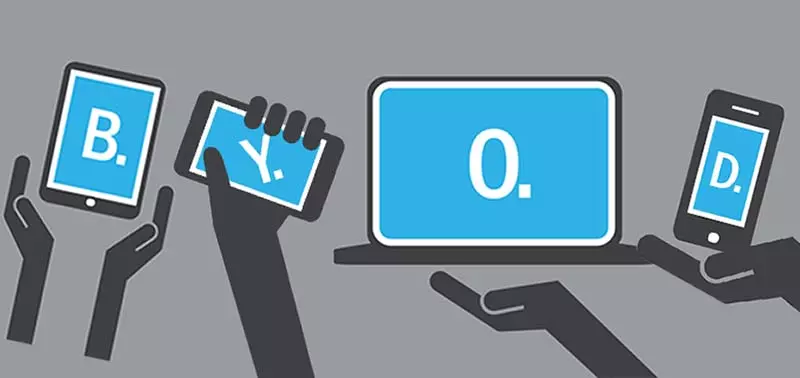BYOD: A Guide to the Benefits, Risks, and Mitigation Strategies
Bring your own device (BYOD) is a growing trend in the workplace, but it's important to understand the benefits, risks, and mitigation strategies involved.

Rise of BYOD Programs in Workplaces
In today's dynamic work environment in businesses and organizations, the concept of Bring Your Own Device (BYOD) has gained considerable traction, reshaping how businesses operate and employees work. BYOD (Bring Your Own Device) in workplaces refers to the practice of allowing employees to use their personal devices, such as smartphones, laptops, and tablets, for work-related tasks and accessing company resources. The BYOD (Bring Your Own Device) policy has gained popularity since 2016 with companies looking to increase efficiency by creating a friendly employee environment.
In the 2020-2021 Covid-19 pandemic, almost all organizations were forced to adapt to virtual workspaces, with employees working from home, exponentially increasing the adoption of BYOD practices among employers. The need for remote work capabilities surged, prompting businesses to swiftly implement BYOD policies to enable their workforce to seamlessly continue operations from their personal devices. This accelerated adoption highlighted the importance of effectively managing the risks associated with BYOD while capitalizing on its benefits. As companies navigated through unprecedented challenges during the pandemic, understanding the implications of BYOD became paramount, making it crucial to explore strategies for maintaining data security, safeguarding employee privacy, and ensuring the resilience of their digital infrastructure.
While BYOD can offer several advantages, such as increased flexibility and productivity, it also comes with various risks that organizations need to carefully consider and manage. In this article, I will explore the benefits, various risks associated with BYOD, and how organizations can mitigate them to foster a secure and productive BYOD environment in a post-pandemic era.
Benefits of a BYOD Program in a Business/Organization
1. Increased Productivity From an Empowered Workforce:
Enabling your employees to use their preferred devices has a profound impact on their productivity and efficiency. Familiarity with personal devices translates into a great work experience, fostering a sense of responsibility and independence. Employees can seamlessly transition from personal to work tasks, saving valuable time that might otherwise be spent familiarizing with unfamiliar devices. This newfound agility has the potential to boost productivity levels and overall job satisfaction.
2. Cost Savings:
Every cent saved counts in today's competitive business market. BYOD offers a compelling solution to cut down on unnecessary expenses. Adopting a BYOD policy allows the organization to save money on purchasing and maintaining expensive hardware. The redirected budget can then be invested in more strategic areas, giving your company a competitive edge.3. Employee Satisfaction and Flexibility:
Embracing BYOD demonstrates your organization's commitment to promote a healthy work-life balance for your employees. The option to use personal devices for work-related tasks empowers employees with the flexibility to operate beyond the confines of the office, which not only improves job satisfaction but also facilitates remote work, providing your team with the freedom to work from virtually anywhere. In the 2020-2021 Covid-19 pandemic, almost all organizations were forced to adapt to virtual workspaces, with employees working from home. Organizations that had a well absorbed BYOD policy seamlessly transitioned to virtual spaces. However, those that relied on in-premise employees-only struggled to accommodate employees working from home, on their personal devices. This challenge forced organizations to buy and configure new devices and deliver them to employees' locations. Through BYOD, workers have the opportunity to operate from remote locations and maintain connectivity beyond the confines of the office, cultivating a work environment that prioritizes flexibility.
Risks Involved with BYOD in the Workplace:
1. Security Concerns
One of the primary risks associated with the BYOD policy in organizations is the security vulnerability it introduces. Most personal devices typically lack the same robust security measures as company-provided ones. This makes them more susceptible to malware, data breaches, and cyber-attacks. Understanding, and accepting, these potential threats is the first step towards safeguarding an organization's digital space.
2. Data Leakage:
The coexistence of personal and work-related data on the same device can unintentionally lead to data leakage. Employees might unknowingly share confidential company information with unauthorized individuals or store it in insecure locations. Implementing strict data access controls can help shield sensitive information from unintended exposure.
3. Regulatory Compliance:
Governments and industries, particularly in the developed countries, have strict compliance regulations regarding data privacy and security. When using personal devices, companies may find it challenging to ensure compliance with these regulations.
4. Lost or Stolen Devices
There is always a risk of losing a personal device, and with it, any sensitive work-related data. In the event of theft or misplacement, critical information might fall into the wrong hands.
5. Device Compatibility and Support:
The wide array of device types and operating systems can create compatibility and support challenges for IT departments with the organizations. Ensuring smooth operations across various devices requires a well-thought-out approach, such as implementing cross-platform solutions and providing technical training to employees.
6. Employee Privacy Concerns
This aspect holds significant importance in the digital age, where technology intersects with personal lives. As it is, BYOD allows employers to have access to personal devices either directly or through network access, blurring the lines between personal and professional spaces. An important question is raised on how much access an employer should have to an employee's personal device. Employees have, inarguably, justified concerns about their personal data being accessed or monitored by the company if they use the same device for both work and personal activities.
Strategies to Mitigate BYOD Risks in the Workplace
1. Transparent BYOD Policy:
A well-defined BYOD policy is essential for organizations, encompassing acceptable usage, security protocols, data access controls, and privacy considerations. This transparent policy provides clarity to employees about the extent of employer access to their personal devices, effectively addressing any security concerns they, the employees, may have. Further, the BYOD policy should address which devices are permitted, any reimbursement for using personal devices, and the off-boarding procedure when an employee leaves the organization or wishes to remove their device for the BYOD program.
2. Mobile Device Management (MDM):
Adopting MDM solutions enables organizations to enforce robust security measures on personal devices, including data encryption, remote wipe capabilities, and password requirements. An MDM tool refers to software that empowers IT to automate, control, and secure administrative policies on various devices connected to the organization's network, such as laptops, smartphones, and tablets. In the event of a lost device, where data leakage becomes a concern, the MDM tool guarantees that any company data on the device remains inaccessible and protected.
Additional tools like Mobile Application Management (MAM), Enterprise Mobility Management (EMM), and Unified Endpoint Management (UEM) provide organizations implementing BYOD programs with strong and comprehensive security solutions. These tools complement the BYOD approach by offering advanced features to manage and secure mobile applications, monitor and control various endpoints, and enforce policies across the entire spectrum of devices used within the organization. Together, MAM, EMM, and UEM bolster the security posture of BYOD environments, ensuring that sensitive data remains protected and employees can work confidently from their personal devices.
3. Containerization:
Containerization involves the establishment of isolated and secure compartments called "containers" on personal devices. These containers create distinct work environments, effectively segregating work-related data from personal information. By doing so, the technique ensures the security and protection of work-related data while preserving the privacy of personal data for the employee. In essence, containerization empowers organizations to embrace the advantages of BYOD while effectively safeguarding sensitive company data and respecting the confidentiality of personal information on employees' personal devices.
4. Employee Education
Regularly educate employees about:
The importance of cybersecurity: Inform your employees about the latest cyber threats, attack vectors, and best practices for safeguarding sensitive data.
Safe browsing practices: Employees learn to identify secure websites, detect potentially harmful websites, and understand the risks associated with downloading files from untrusted sources. [Read on Phishing scams: How to Protect Yourself from Phishing Scams]
The risks associated with BYOD: BYOD introduces unique security challenges, and employees need to be aware of the potential risks associated with using personal devices for work. Employees need to understand the potential consequences of lost or stolen devices containing sensitive company information.
By providing ongoing training and awareness sessions, organizations can empower their employees to become the first line of defense against potential cyber threats.
5. Data Backup and Recovery:
Employ regular data backup procedures to minimize the impact of data loss in case of device theft or damage to a device containing sensitive and critical organization data. With employees using their personal devices for work-related tasks, the risk of device theft, damage, or even accidental data deletion is heightened. Implementing scheduled and automated data backups ensures that critical work-related data is duplicated and securely stored in a separate location or cloud-based server. In the unfortunate event of a device being stolen, lost, or experiencing hardware failure, the backed-up data can be easily retrieved and restored to a new device, significantly reducing downtime and preventing business disruptions.
6. Limit Access and Permissions:
Organizations should carefully control the level of access that each employee has to sensitive data, taking into account their specific job roles and responsibilities. A best practice is to grant employees the minimum access required for them to perform their tasks effectively. This approach helps in mitigating the risk of unauthorized access to sensitive information on personal devices while allowing employees to carry out their duties efficiently. By implementing granular access controls, organizations are guaranteed a strike of balance between maximizing productivity and safeguarding confidential data, ultimately promoting a secure and compliant BYOD environment.
6. Regular Auditing:
Conducting periodic security audits is a fundamental practice to ensure the ongoing safety and integrity of company data in the ever-evolving digital landscape. These audits serve as proactive measures to identify potential vulnerabilities that may arise from employees using their personal devices for work-related tasks. By thoroughly assessing the security infrastructure and all BYOD policies, organizations can pinpoint weak points and areas that require improvement and promptly address them thereby reducing the risk of data breaches and cyberattacks. It is imperative that organizations embrace a proactive approach through regular security audits, allowing them to foster a resilient BYOD environment that safeguards sensitive information while fostering a culture of security awareness among employees.







